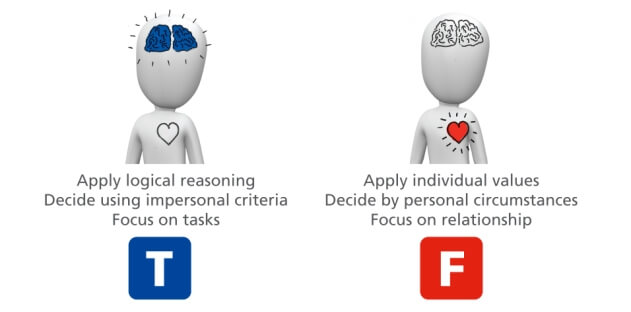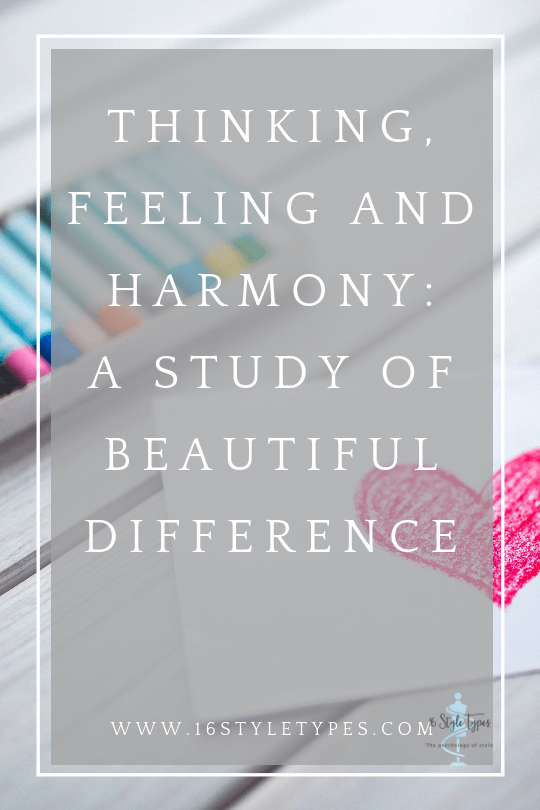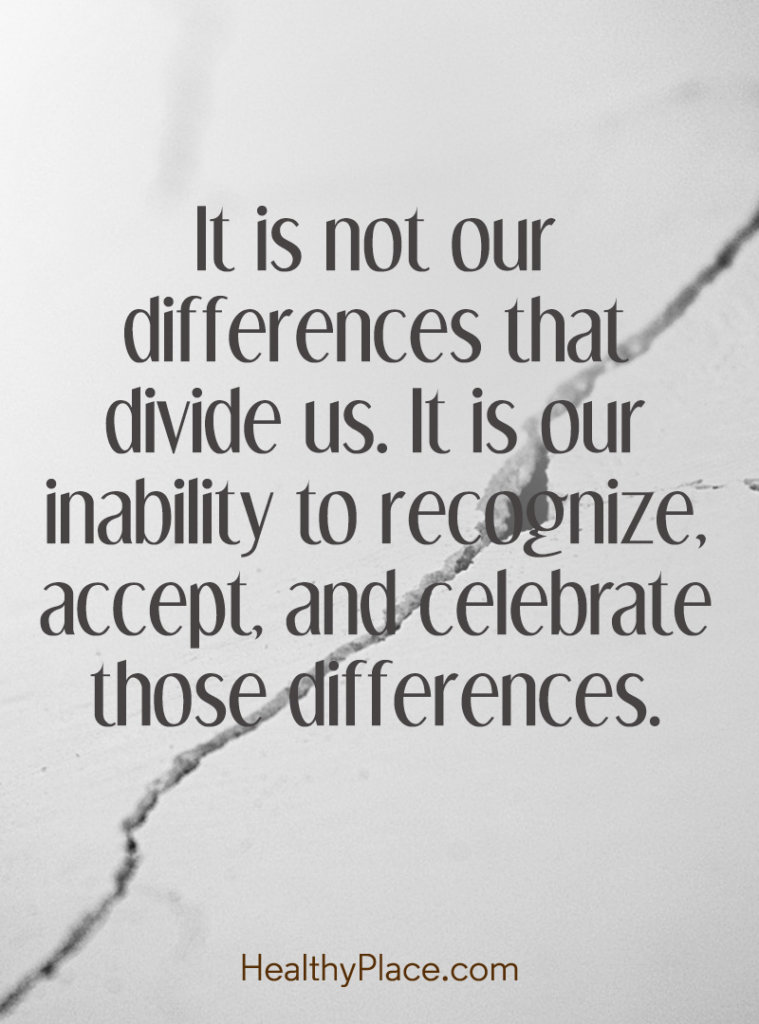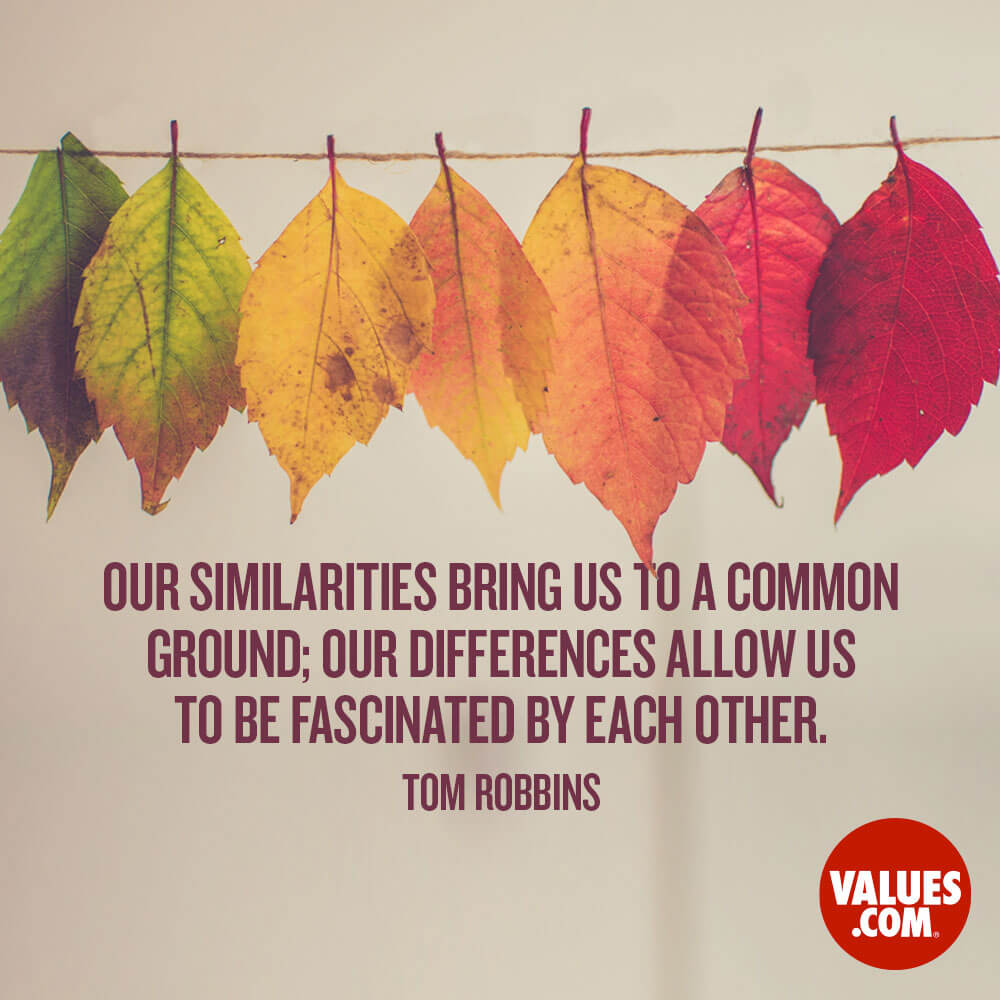By Jill Chivers with input and inspiration from Jane Kise
In our online membership program, Your Type of Style, an intriguing conversation was struck up when one of our peer facilitators, with preferences for INFJ, shared that it was important for her to be part of a harmonious group.
Such a simple statement, right?
Well as it turned out, it generated a terrific conversation about harmony, and specifically harmony in groups. We thought this would be a great opportunity to talk here some more about some of the key differences between those with a Thinking preference and those with a Feeling preference.
Valid and Innate
Thinking and Feeling are both valid ways of making decisions. They are equal and opposite. Neither is better nor worse than the other, and in fact they provide balance.
In dynamic psychological type terms each of us has an innate preference to one over the other: We either prefer Thinking over Feeling in decision making, first considering objective criteria, potential precedents, probable gaps or errors and so on… or the opposite where we prefer Feeling over Thinking, first considering whether values are being upheld and the impact on various stakeholders as our dominant decision making function.
This does not mean that those who prefer Thinking never feel, or use Feeling. Or that Feeling preference people never think or use Thinking. Such a notion doesn’t hold up to even the briefest of scrutiny, and is rather absurd when you think about it even for just a moment.
Both Thinking and Feeling preference people can be passionate about things that really matter to them.
There’s also some intriguing discussion about gender stereotypes and this aspect of Type, which we’ve written about in this article on women who prefer Thinking.
What’s the Difference?
To encapsulate the essence of Thinking and Feeling, here’s a summary of the differences:
Thinking is concerned with objective truth-seeking and making decisions on impartial information based on logic.
Feeling is concerned with personally held values and making decisions that factor in the impact on people.

Differences in decision making – Thinking and Feeling | Graphic source: The Myers-Briggs Company, https://eu.themyersbriggs.com/en
The Exchange
Getting back to our online conversation about harmony in groups. Here are some excerpts, used with permission, from that conversation between our Feeling preference person (preferences for INFJ) and our Thinking preference person (preferences for ENTJ).
This exchange has some key features:
- It beautifully illustrates some of the differences in how Thinking types can approach groups, and how Feeling types often prefer to be in a group setting
- It occurred between two people who know their own Type and have some understanding of other Types
- The two people involved come from a place of caring and respect for the other, and of self-acceptance
- There’s a mutually supported, if unstated, goal of coming to an understanding and shining the light of awareness on a topic of interest to both
There are many variations on this theme of T-F differences, and what is below is one flavor.
Let’s Talk
Feeling: It’s important that any group I belong to is harmonious.
Thinking: Could you expand upon what you mean by wanting a group to be harmonious? That is not a word I would ever think to apply to group learning.
Feeling: Not fighting, all getting along with each other. I hate to be in groups where there is open discord. There’s also something about esprit de corps – coming together for a common purpose, looking out for each other as we engage in that pursuit. I dislike hierarchies or people playing power games – putting others down to make themselves feel better, taking credit for ideas that weren’t theirs, bullying or intimidation, or even subtle but sometimes devastating sarcasm.
Thinking: My hopes would be that the group was interesting, thoughtful, challenging, supportive, gave meaningful and direct feedback.
Feeling: I have been part of groups where participants “locked horns” and have hated the resulting atmosphere of conflict and deliberate provocation. I have wept tears of frustration as my emotional and spiritual well-being were shattered. Especially in groups where deep inner work is being done and you’ve worked to become extremely sensitive to the subtleties of your inner landscape (I suspect this may relate to my preferences for INFJ), any turmoil in the outer world is even more upsetting than usual.
Thinking: I think we are all in agreement but the specific word means different things to different people. To me it brings up my mother’s difficulty in even hearing an opposing view when given respectfully. I came to learn that harmony means no disagreement.
Feeling: Sometimes harmony is about the joy of being engaged in pursuing a common goal with like-minded fellow travelers, and being clear and happy about what the goal is. Sometimes it’s about the way in which the goal is being sought. It’s not that this can’t be thought-provoking or challenging (that’s what makes it worth pursuing) but that we all feel accepted, valued and appreciated for our contribution, even if we disagree. If circumstances aren’t right for me I just go quiet, withdraw and don’t participate at all.
Thinking: Thanks for clarifying. The other way I use it is referring to music or other arts and in that it is a lack of discordance.
Let’s unpack some elements of Thinking-Feeling difference, with the above conversation as a jumping off point for further exploration into this intriguing territory.
Thinking, Feeling and “Harmony”
- Harmony is a subjective term open to huge differences in interpretation, with our Type preferences being at least partially responsible for the definition we favor and use.
- Harmony isn’t always a positive term for some and a harmonious group is not always the best purpose of a group or a worthy pursuit for group leaders to foster. For some people and circumstances, prioritizing harmony as a group goal can actually get in the way of groups achieving their purpose (stated or implied). Putting harmony first as a group goal can cause some people to feel silenced and that their contributions can’t be shared; it can close the learning door for them.
- Some people cannot be part of groups where there is no harmony (by their definition). Discord of any sort is so disruptive to their psychological wellbeing that they would sooner not be part of the group than be witness to open discord, and they certainly do not wish to participate in anything resembling disagreement or debate. Disharmony is toxic to them and they cannot learn anything in an environment which is not transparently harmonious with ‘everyone getting along’.
Interestingly, in the above circumstances, each is looking for a place where they can be accepted and contribute. The requirements for each is just so very…. different.

When things go wrong between Thinking and Feeling preferences, it can be like looking into a shattered mirror – distortion, fractures, fragments.
On the Dark Side of the Spectrum
Sometimes significant misunderstandings occur, where meaning or intent is assigned to behavior unfairly or without checking assumptions on whether what you’re believing to be true is accurate or fair.
When there is not enough understanding of legitimate and innate differences, when issues are especially meaningful or consequential, or when we are ‘triggered’, less than positive aspects can come up for Thinking and Feeling types in relationships.
When Thinking Goes Wrong for Feeling
Feeling preference people can feel intimidated and patronized when confronted with Thinking behavior, causing them stress and for them to feel less than their best, even inferior.
Thinking preference behavior and language can seem at times to be condescending – with Thinkers making statements that seem to preclude the possibility that others don’t know and therefore need to be informed or taught.
Thinking behavior can seem hierarchical with T’s appearing to take a superior position where they know best (or know everything), issuing orders or making statements without considering other’s perspectives or need to be heard or consulted with.
Feeling types can become fatigued by what appears to be debate or disagreement, it can seem like a form of jousting where some kind of ‘damage’ could be done, some hurt inflicted, however unintentionally (which can be part of the problem- the lack of awareness of people).
It can also be tiring to be surrounded by so much seeming negativity – the flaws being pointed out, the gaps in logic being brought to light, opinions or facts being disputed – it can become heavy and wearisome, even oppressive.
When Feeling Goes Wrong for Thinking
Thinking preference people can find Feeling behavior illogical to the point where they lose respect for the person – they’re saying nonsensical things or behaving in a way that seems so random that they can’t follow it or make any sense of it.
Feeling preference behavior can seem unstable or out of control to Thinkers who can become alarmed or disquieted by the peculiar need to attend to non-task issues, which can seem beside the point to them. They can be annoyed that their time is being wasted.
Thinking types can become fatigued by the need to have to constantly explain that “it’s not personal” and can feel manipulated into subscribing to what can seem like a false sense of harmony with everyone putting on a happy face and pretending to be getting along.
They can feel that they have to constantly tip-toe around Feelers and not reveal their true thoughts or opinions for fear of hurting feelings and creating disharmony inadvertently and so close down communication channels.
It can be tiring to be around Feeling types who can seem overly sensitive, high maintenance in one way or another, likely to become bent out of shape at any (random) time, and requiring time and attention on issues or niceties which aren’t considered necessary or central to more significant concerns.
When it’s Bad, it’s Baaaad
When things go wrong, they can go very wrong. Another reason it’s so important to understand that harmony and disharmony aren’t the sole purvey of any one Type and to have some useful tools to move beyond difference.
Misunderstanding on the Thinking-Feeling dichotomy is a horrible place to become stuck.

Why Each Dislikes Disharmony
Sometimes concepts of harmony and disharmony are attributed to the Feeling preference types, which is something of a stereotype. Thinking people can also dislike and avoid disharmony, but usually for quite different reasons to their Feeling friends.
This is why getting to the “why” is so important when it comes to understanding Type (and why typing from afar can be so problematical!).
Thinking and Disharmony
Thinking preference people often dislike and will avoid disharmony, but their reasons are often quite different to Feeling preference people.
Some Thinkers can feel incompetent in the face of disharmony and not know how to behave or what to say which is deeply uncomfortable. Other Thinkers simply cannot make sense of what they’re hearing or seeing as it seems to defy the logical principles they hold so dear.
Feeling and Disharmony
Feeling preference dislike harmony for varying reasons, one being that personal values are violated – sometimes there’s awareness these personal values exist, but sometimes it’s the act of violating them that brings them to the surface and into consciousness.
Other Feeling preference people may feel connection to others has been lost when there’s a difference of opinion, or that the welfare of others has been compromised when their opinions are disagreed with.

The first step is awareness: seeing and acknowledging legitimate differences
Working Together
Thinking and Feeling are equal yet psychologically opposite ways of making decisions. We each do both – just not at the same time, with the same level of ease or ability, or with the same amount of innate energy.
So how can Thinking and Feeling types work together to ensure balance, respect, caring, and a great outcome (in whatever terms that happens to be, whether it’s a couple planning their vacation, a boss working with her team, or a bunch of volunteers helping out at a fund raiser)?
One way of navigating through differences is to use a tool such as State Your Path from Crucial Conversations.
This approach factors in the innate differences of both Thinking and Feeling, and provides a trusted pathway for each to contribute in their own way to the conversation.
STATE as a process does not force one person to become more like the other, which can show up when Thinking preference people demand Feeling people become more logical or Feeling preference people decry the lack of sensitivity in their Thinking partner.
This approach also helps each person understand how they came to the spot they’re in now – it gets to the all-important “why”, and to slow down and listen.
How to STATE
With this approach, it works well if one person goes first and talks through the first two steps from their perspective. The other person listens, as openly as they can (easier said than done when the stakes, or emotions, are high). Often the person that goes first is the one seeking a mutually respectful discussion and believes a protocol would help – by going first, she can model the approach and allow the other to gather their thoughts before having their turn.
With an approach like this, people often discover their points of intersection quite quickly and often easily. What they discover is a fascination that their internal experiences and external behavior differs in important yet understandable ways.
How interesting that they don’t use the same vocabulary or the same definitions for simple words (like “harmony”) and that what is excruciating for one can be stimulating for the other, and vice versa!
State Your Path for Crucial Conversations
STATE is an acronym and stands for:
S – Share your facts. What do you believe happened? This is a describing step: no assigning of judgment or editorializing. “Just the facts” – what was said and done.
T – Tell your story. What happened for you? What was that like for you? How did you feel? What do you think? What are you making this mean? What conclusions might you be beginning to draw?
A – Ask for the other’s paths. Be curious about the other person’s facts and story. Lean into the listening, as much as you can.
T – Talk Tentatively. Be aware you may be working on untested assumptions which turn out to be wrong (utterly or in some important way that changes the complexion of the conversation). Keep definitive, declarative statements to a minimum – be curious instead.
E – Encourage Testing. Avoid ‘dropping anchor’ on the person or the situation. Suspend judgment and keep your learning door open to what you might discover – about yourself, about the other, about what’s really happening between you, about where you might end up
You may find additional reading, such as this piece, will expand your understanding of the State Your Path process.

Getting to Clear Ground
However you define a successful outcome, getting to some form of clear ground — clear of little landmines which can sabotage understanding and a healthy relationship — is helpful.
Here’s some things to remember as you navigate through the intriguing decision-making territory of Thinking and Feeling and use Type as a lifelong guide to self-discovery.
Both Thinking preference and Feeling preference people can become confused, frustrated, and upset by the behavior of the other.
Remember that both aggressive and passive-aggressive behavior sabotage harmony, no matter how you define it.
Questions to ponder: How might you respond in a healthy way to either behavior should you encounter it? How can you be on the alert for either behavior in yourself?
Both Thinkers and Feelers can withdraw from relationships and situations which they find fatiguing and confronting.
Thinking types may dismiss others as incompetent, while Feeling types might dismiss others as harsh or uncaring.
Questions to ponder: How might you be misjudging others’ behavior, or assigning intentions which aren’t accurate or fair to it, when what’s really happening are valid yet different rules of discourse? How can you be more open to legitimate differences in the other whilst claiming and honoring your own needs and preferences?
Both wish to be understood and have their best intentions assigned to their behavior.
Questions to Ponder: What intentions are you assigning to the behavior of the other? What assumptions are you making? How can you move beyond assumptions? What positive response from you might help shift a conversation back to a successful pathway for both?
Both wish to be able to “be themselves” and be accepted for who they innately are.
Questions to Ponder: How can you help each other reframe and re-balance the Thinking, logical approach with the Feeling, stakeholder-centered approach? How can you balance your own needs and preferences (to be understood for who you innately are) with the different needs and preferences of another?















Many years ago, I attended a department meeting at the tech company where I worked. The dept directo sat at one end of the table; the systems administrator was at the other. I was in the middle on one side with a great view of both.
The director leaned forward and, with shining eyes, announced that she hoped “We will all agree with each other on the outcome of this meeting!!!” (exclamation points hers).
The Sys Admin leaned back and said “We don’t have to agree with each other. We only need to make a decision and move forward.”